Willy Gehler – edge research, political self-mobilization and historical assessment
Table of contents
Project data
| Titel | Title Willy Gehler (1876–1953) – Spitzenforschung, politische Selbstmobilisierung und historische Rezeption eines bedeutenden Bauingenieurs und Hochschullehrers im „Jahrhundert der Extreme“ | Willy Gehler (1876–1953) – edge research, political self-mobilization and historical assessment of an important civil engineer and professor in “the century of extremes” Förderer | Funding Deutsche Forschungsgemeinschaft (DFG) Zeitraum | Period 11/2014 – 10/2017 (Phase 1) 11/2018 – 09/2022 (Phase 2) Leiter | Project manager Prof. Dr.-Ing. Dr.-Ing. E.h. Manfred Curbach Bearbeiter | Contributor Dr.-Ing. Oliver Steinbock Projektpartner | Project partner Lehrstuhl für Technik- und Technikwissenschaftsgeschichte, TU Dresden |
Report in the year book 2019
WILLY GEHLER – ON THE TRACKS OF AN RC PIONEER
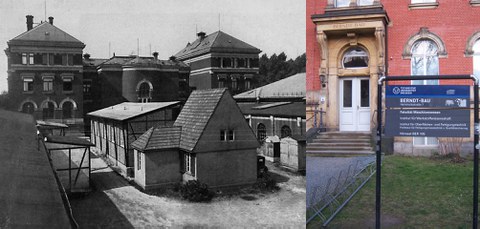
View of Dresden testing office (VMA), nowadays Berndt-Bau
During the years of 2014 – 2017 the German research community (DFG) promoted a project about the work and life of Willy Gehler. On the basis of this first research period, an additional phase was approved in 2019 because of the unexpected result of the first phase. Again, the chair for Technology and History of Science and Technology and the Institute of Concrete Structures are working together to investigate the values of his personality and his scientific expertise.
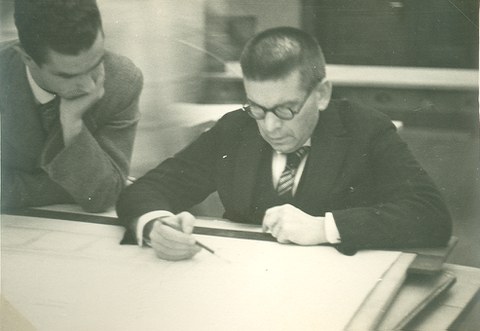
Gehler during an exercise together with a student
The focus in the first phase of the project was about the contributions of Gehler to the reinforced concrete research, during the first half of the 20th century. Of particular interest is his work as director of the Testing and Material Office (VMA) Dresden. Following the existing references, we found out more about Gehler’s research in the field of prestressed concrete structures. In detail, it was found that the competing systems of Hoyer and Freyssinet were evaluated in Dresden for the first time. The main features of the so-called Hoyer Effect were the focus of investigations and tests conducted by Erich Friedrich Dresden at the VMA in Dresden. Apart from that Gehler had many qualifications beyond the reinforced concrete. The main topic of the second phase will be his research about steel constructions. The first findings showed that he worked in close collaboration with Ernst Chwalla. He became well-known for his research about the buckle of compressed profiles. This context shows that a widespread view is necessary to capture Gehler’s complex personality. Therefore the scientific field will be extended by network analysis. The analyzation will help to clarify the political position, involvement and collaboration during the two German dictatorships as well as a judgement of Gehler’s identity as academic persona non grata.
Report in the year book 2017
WILLY GEHLER – ON THE TRACKS OF A RC PIONEER
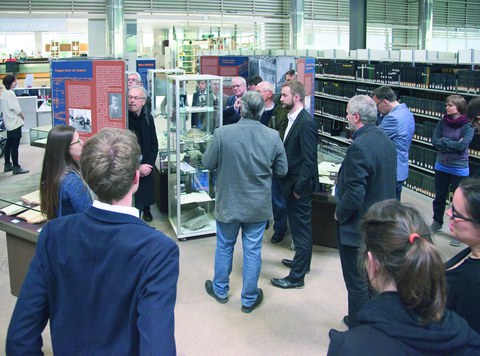
Opening of the Willy Gehler exhibition at the DrePunct Library, SLUB Dresden
Willy Gehler (1876–1953) was a pioneer of reinforced concrete (RC) construction, but up to now, his work is barely known within the civil engineering community. Due to his political involvement as a member of the Nazi Party, among other previous political affiliations, he is still a controversial figure. As opposed to this, based on the findings of the current research project about him, there is no debate about his scientific achievements in the field of civil engineering, as our research’s focus has primarily been on the publications of his research results, and the research’s motivation was to draw attention to Gehler’s work and his merits. It began in April 2017 with a workshop about Willy Gehler, which professionals of the history of construction technology attended. The results of this workshop are summarized in the conference proceedings. In addition to this, an exhibition was opened at the Departmental Library DrePunct of the Saxon Regional Library – State and University Library (SLUB). It was organized in collaboration with the Chair for Technology and History of Science of Technology, as a part of a practical seminar with students. An accompanying brochure, which is also available online, is meant to provide information about the exhibition and findings. The exhibition will remain at TU Dresden until March 2018. Afterwards, the exhibition will be moved to the BTU Cottbus-Senftenberg.
The complexity of Gehler’s personality and the inherent conflict between industry, administration, and science was the main focus of a presentation at the annual conference of the Association of Building History. From the industry’s perspective, his practical work in the concrete building company ‘Dyckerhoff & Widmann‘ which was inspiring back then, is particularly worth mentioning. He represented the government, from an administrative perspective, during his career years at the Royal Saxon State Railway. Of particular interests are his substantial contributions in connection with the German Institute for Standardization (DIN) and the German Committee for Reinforced Concrete (DAfStb), as a long-term member of such associations. Most of his time, Gehler took the perspective of science as a full professor of the TH Dresden, as well as director of the Testing and Material Office. Gehler provided pioneering ideas and methods beyond the field of reinforced concrete, which requires further research work to present a thorough image of the sedulous engineer.
Report in the year book 2016
Willy Gehler – on the tracks of a genius?
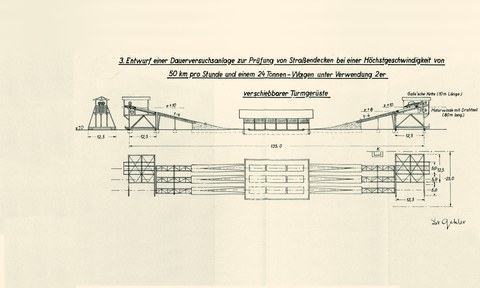
Found in the archive: plan of a testing field for reinforced concrete slabs for streets (1936)
Despite his research merits, and his important role in the development of reinforced concrete, the former professor and civil engineer Willy Gehler (1876–1953) is little known today. One reason may be his murky political affiliations with various political forces throughout four epochs of German history, especially the years spent as a member of the NS-Party. Such a constellation of circumstances and scientific contributions is of interest in today’s research, and it is the reason of an interdisciplinary project in collaboration with the Chair of History of Technology and Technological Sciences of TU Dresden.
This year, the focus laid on extensive historical investigation. In addition to the usual archive search, we looked for constructions which were designed by Gehler. In that context, the bridge over the creek Lockwitzbach in Dresden/Niedersedlitz, probably one of the oldest reinforced concrete bridges in Central Germany, was found. Unfortunately, the bridge was demolished in April 2016 due to a lack of vertical clearance. For our research, it was a stroke of luck that the demolition could be documented. During demolition, both concrete and steel samples were taken, which were available to be analysed in the laboratory. From the investigations, we hoped to gain in-depth knowledge of the material behaviour of historical concretes and concrete steels, which may be useful in evaluating construction projects in existing buildings.
Befitting the wide variety of Willy Gehler’s research, the search in archives was widespread as well. In addition to the archive of the Dresden University, further archives of other universities e.g. those of Munich and Stuttgart were visited. The majority of the relevant holdings of the DAfStb (German Research Association for concrete structures), the main state archive in Berlin and the state archive in Dresden were inspected. This research provided information on possible research projects of Willy Gehler during these epochs. For example, there is evidence that Gehler was involved in the construction of a test facility for concrete road construction for the organization Todt. The searches were further extended to archives of the Russian Federation with a focus on Moscow. It was initially assumed that research documents came to Russia after the turmoil of World War II. This suspicion could not be confirmed at first, but there are clues which point to relations with the Russian Federation for a research transfer effort.
Report in the year book 2015
Willy Gehler – An example of political missteps at the TU Dresden?
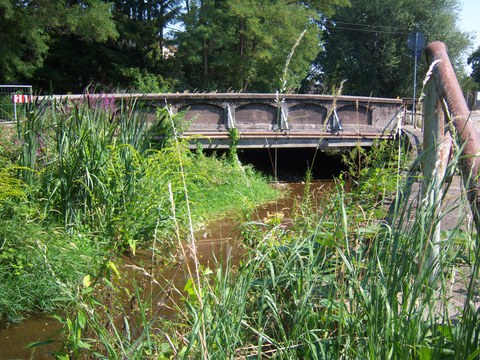
Presumably oldest still obtained reinforced concrete bridge in Middle Germany, planned by Willy Gehler, at the train yard in Niedersedlitz (summer 2015)
In recent days, unpleasant headlines about the refugee policy and the handling of foreigners has portrayed the City of Dresden. In front of all that, TU Dresden has separated itself from right orientated organizations, such as Pegida. That can be attested not only by the uncomplicated process of providing refuges with housing at the TU Dresden sport fields, but also by the anti-demonstrations, the human chains and, finally, the broad student diversity at the university itself. Retrospectively, the interdisciplinary research program “Willy Gehler (1876–1953) – edge research, political self-mobilization and historical assessment of an important civil engineer and professor in “the century of extremes” is an important part within the analysis of the university history during the NS-era and the early postwar years.
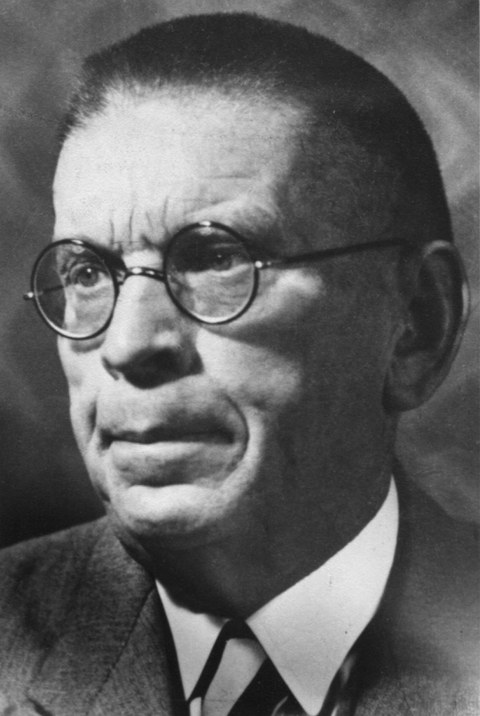
Willy Gehler (ca. 1950)
The former professor and civil engineer Willy Gehler lived during four epochs of German history. Born in the German Empire, he started his career in the civil service (Royal Saxon State Railways 1900–1904) after completion of his mathematic and civil engineering studies.
After changing from the civil service to a private company, he successfully raised thru the ranks of his new employer, Dyckerhoff and Widmann, and became involved in major projects such as the lateral platform hall of Leipzig Station or the Centennial Hall in Breslau. In 1913/14 he was appointed as a full professor at the Civil Engineering Faculty of the TU Dresden. During the First World War, he became the head of the War Testing Office. After that, he was in charge of the material testing laboratory in Dresden. Through the era of the Weimar Republic, he was very interested in the new material “ferroconcrete”. We also suspect that he was involved in the NS war research, after joining the NSDAP party in 1933. The extent of his possible political involvement during that time as well as his pure scientific achievements are both part of our research. After Second World War, it was no longer possible for him to work as a professor at the university. But even then, under the new political circumstances, he came along. Gehler’s continuous adaptation to the political constraints coupled to his technical expertise as an engineer puts him at the center of a particularly interesting research project.
